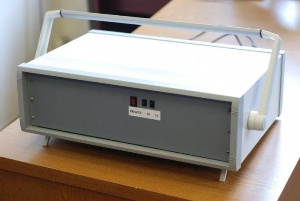Jun 18 2014
MIPT's Laboratory for the Spectroscopy of Planetary Atmospheres has come up with a high-resolution meter to gauge the concentration of gases in the atmosphere with unparalleled precision.

Laboratory for the Spectroscopy of Planetary Atmospheres of Moscow Institute of Physics and Technology has come up with a high-resolution meter to gauge the concentration of gases in the atmosphere with unparalleled precision. The infrared spectrum radiometer is described in an article recently published in the journal Optics Express.
The paper, authored by Alexander Rodin, Artem Klimchuk, Alexander Nadezhdinsky, Dmitry Churbanov and Maxim Spiridonov, says that the new spectrum radiometer is 100 times more precise than the best available near-infrared spectrometers, and 10 times more accurate than a meter created on a similar principle recently described by NASA's Goddard Center.
Tracking down carbon dioxide, methane and other gases with simultaneous determination of their concentrations at different altitudes is necessary, in particular, for research into global warming. The vast majority of scientists do not doubt the correlation between growing temperatures on the planet and the greenhouse effect, but so far it has been impossible to positively predict future changes in global warming. A current lack of data on the distribution of greenhouse gases also compromises the forecasting and, consequently, the development of appropriate response measures. This is because in order to create a dense network of monitoring stations, many large, sophisticated and expensive spectrometers are needed.
The meter created by the Russian scientists is distinctive not only for its very high resolution, but also for its easy maintenance. The authors of the paper stress that their meter is far less susceptible to external disturbances compared with existing analogues. Its performance depends to a lesser extent on vibration, humidity and exposure to both low and high temperatures.
Alexander Rodin explained that the meter uses the heterodyne principle, known for over 100 years. The essence of the method could be best described as follows: a received signal is added to a reference signal to form an intermediate frequency signal. Generally, it does not matter whether it's a radio wave or sunlight passing through the atmosphere, as is the case in the new meter.
The converted signal is much easier to process, namely to amplify and to filter. Moreover, when the frequency of the reference signal is sufficiently stable, extremely high sensitivity can be achieved. The only problem is that a signal of very high frequency, whether it is infrared or optical, is not so easy to add to the reference source – it must be very stable and at the same time emit radiation of high intensity.
The first heterodyne radios, operating at megahertz frequencies, were created in the early 20th century, becoming mass-produced toward the end of the Second World War; while in the terahertz sphere heterodyne devices appeared only recently. For near-infrared radiation, whose frequency is a few hundred times greater, the task of combining the signals appeared to be compounded by a number of technical difficulties.
Calculations showed that a more "touchy" device is needed for a heterodyne signal in the near infrared radiation spectrum. Even a shift of a few hundredths of a wavelength (i.e. a couple of dozen nanometers) could be critical, but eventually the researchers from MIPT and their colleagues from the Moscow-based General Physics Institute managed to create a heterodyne near-infrared detector, in which a key role was played by laser stabilization.
They used an optical system that directs a laser beam to two different points, one of them a special module for mixing it with sunlight passed through the atmosphere (i.e. the analyzed signal) and the other a cell with a pure sample of the gas to be identified. Since the gas absorbs electromagnetic waves at a specific frequency, the brightness of the radiation going through the cell indicates how far the laser has deviated from the reference frequency. And this, in turn, makes it possible to adjust the frequency of the optical oscillator, i.e. laser (the word laser is an acronym of "light amplification by stimulated emission of radiation").
New spectrum radiometers may be used at both stationary and mobile stations monitoring the atmosphere, according to the official site of the IVOLGA project, which is another abbreviation translated from Russian as "infrared heterodyne fiber analyzer."